The genus Alocasia is made up of around 80 Species and dozens of hybrids. They are generally herbaceous perennial plants that come from tropical regions in Asia, Africa and Australia; and are closely related to taro plants (Colocasia spp.).The plants can grow to an enormous size to provide shade and a lush, tropical feel to outdoor landscaping. These plants are also referred to as elephant ears due to the appearance of the leaves attached to the leaf stem. The leaves are oval at the base and taper to an arrow point. The surface of each leaf has prominent, multi-colored veins.
In other words, Alocasia leaves tend to take interesting shapes, most notably either heart or arrow-shaped, and can reach between 12 and 36 inches long, born as individuals on sturdy stems. Their inflorescences, or small clusters of flowers sprouting from the stems, are surrounded by a leaf-like structure called a spathe. Many types of Alocasia can grow up to a foot in a single growing season. With leaves ranging in colors from silver to green, along with distinct veins, these perennials provide a tropical aesthetic to any indoor location when you choose cultivars with smaller leaf sizes.
Alocasias give a tropical feel to a garden, patio or indoors. They are best in tropical and sub-tropical climates, but can also grow in temperate areas in a warm spot.They are suited to garden plantings, as a single specimen or massed planting, as well as being great for containers. They can make good indoor plants, but need bright light and misting to do well for longer periods indoors.
- Alocasia Longiloba
- Alocasia Macrorrhizos
- Alocasia Cuprea
- Alocasia Morocco
- Alocasia Amazonica
- Alocasia Micholitziana
- Alocasia Zebrina
- Alocasia dragon scale
- Stingray Alocasia
- Alocasia Melo
- Alocasia Reginula
- Alocasia Cucullata
- Alocasia Portodora
- Alocasia Sanderiana
- Alocasia Rubra
- Alocasia Lauterbachiana
- Alocasia Baginda
- Alocasia Wentii
- Alocasia Odora
- Alocasia Nebula
- Alocasia Reversa
- Alocasia Scalprum
- Alocasia Infernalis
- Alocasia Brancifolia
Alocasia Longiloba

Alocasia Longiloba has huge arrow shaped leaves of a bluish green colour, with silver margins and veining. The flowers are held on a spadix enclosed in a green to white coloured spathe. It generally grows to between 1-1.5m. They can make good indoor plants, but need bright light and misting to do well for longer periods indoors.
Alocasia macrorrhizos

Alocasia macrorrhizos, commonly called giant taro or upright elephant ears, is a popular Alocasia variety treasured both for its giant ornamentally decorative leaves which resemble the ears of an elephant and its edible rhizomes which have been cultivated for many years in the tropics as an edible vegetable under the common name of taro. The entire plant can eventually grow to as much as 3-5 feet tall in optimum growing conditions with a spread of about 3 feet wide. Flowers are not particularly showy and bloom intermittently throughout the year.
Alocasia Cuprea

The name “cuprea” refers to the coppery tint of this plant’s leaves, a glossy, almost plastic bright green with lighter veins and a reddish underside. It has a small white to green spathe, and the spadix bears its small blooms for only about 3 days before fading, usually in late spring to early summer.The compact size of the Alocasia Cuprea, makes this plant a great candidate for a houseplant. It stands at around a foot tall, while its leaves can get even bigger.
Alocasia Morocco

Alocasia ‘Morocco’ but I am also known as Elephant Ear ‘Morocco’ have a large flat deep dark green leaves with white veins. Undersides of leaves and dark burgundy red and stems are pink. A truly beautiful pot plant or under-storey plant in shady yet brightly lit positions in the garden.
Also Read: Different Types of Anthurium Houseplants
Alocasia Yucatan Princess
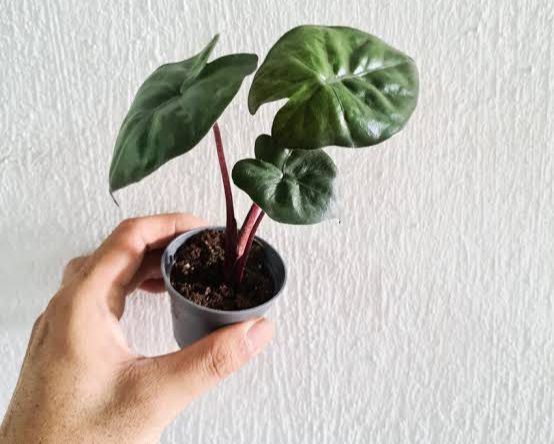
Alocasia Yucatan Princess is distinctly bold and exotic looking and generally grown for its foliage. This particular elephant ear grows 4-8 feet tall and holds its glossy leaves high on strong chocolate brown stems. The leaves unfurl to puckered glossy gray-green leaves with maroon undersides. This plant rarely flowers, but when it does, the blooms are a creamy white. The plant makes a dramatic addition to any warm season garden as container plants.
Alocasia Amazonica

The Alocasia amazonica, or African Mask plant is a hybrid variety featuring leathery, wavy-edged, arrowhead-shaped, dark bronze-green leaves with conspicuous, contrasting, thick white to silvery-green main veins. In proper conditions, each leaf can grow as long as 16 inches.The plant will grow quickly, reaching a mature height of up to 2 feet. Amazonian elephant ear plants rarely bloom (especially indoors), and are grown primarily for their eye-catching foliage.
Alocasia micholitziana

Alocasia micholitziana, commonly known as the green velvet taro or green velvet alocasia is a rare, glamorous specimen with an elegant touch. The soft velvet leaf texture is complimented by the iconic arrowhead shape. What makes this alocasia unique are the sharp, white veins that dissect the deep green leaves.This plant has dark green to black leaves with prominent lateral veins that are a bright white. The leaves can grow up to 18-inches long.
Alocasia Zebrina

Alocasia zebrina is one of the most decorative houseplants on the market. Its distinctive, patterned stem and large leaves have earned it the nicknames ‘zebra alocasia’. The leaves are distinctly heart-shaped and grow at the end of a striking stem, which is usually striped green and white. The Alocasia zebrina grows to about three feet high and wide. It can be considered rather fast-growing in the warm season, putting out leaves once every two weeks under ideal conditions. It sheds older leaves naturally and replaces them with new foliage.
Alocasia Stingray
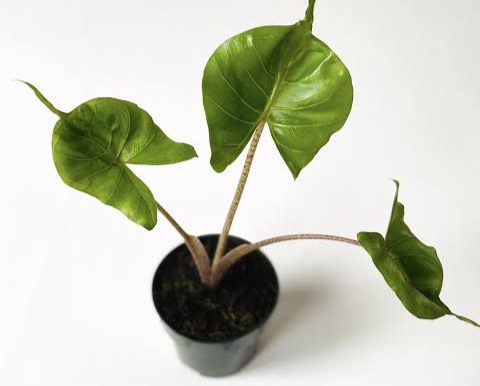
Alocasia Stingray’s shape resembles that of a marine animal. This is where the name ‘Stingray’ came from. Its special features include large leaves and a distinctive stingray shape, which points upward and outward, showing the ribbed, wrinkly, and mono-colored green surface. It can grow up to 1 to 1.2 meters high. It’s fast-growing if you can ensure ideal environmental conditions. Alocasia Stingray has a unique and simplistic beauty that improves your home style.
Alocasia Melo

Alocasia Melo is commonly known as Alocasia Rugosa for its unique foliage. Its leaves are green, large, and thick with a rough texture that makes it look like an artificial plant. This alocasia is considered a small plant because although in nature it can grow up to 23 inches in height, as a houseplant it is not usual, and does not exceed approximately 15 inches.This terrestrial growers can beautify any corner in your house to add the necessary oomph to the decor.
Alocasia Reginula

Black Velvet Alocasia (Alocasia reginula), or Little Queen, is exotic and elegant, featuring dark leaves and prominent pale green, white, or silver veins. Its thick, succulent-like leaves are heart-shaped and have a velvety look and stiff texture. The leaves grow about six inches long and two-and-a-half inches wide.This plant makes a striking statement on a windowsill or interior scape.
Alocasia cucullata

The Alocasia cucullata has beautiful heart shaped glossy green foliage with prominent veins on tall green stems. This evergreen plant is durable and easy to care for, and so it is easy to plant outdoors or indoors in containers.The leaves grow to become 15 inches by 11 inches. Also known as Buddha’s hand it is believed to bring good fortune and is often kept in Buddhist temples across its native Thailand and Laos.
Also Read: Different Types of Begonia Houseplants
Alocasia wentii

Alocasia wentii goes by a few common names, including “Purple Umbrella,” “New Guinea Shield” and, encouragingly, “Hardy Elephant Ear.” It is thought to be a hybrid between Alocasia Odora and Alocasia Gageana. Alocasia wentii’s glossy green leaves have its family’s classic broad shape and feature a slightly ruffled texture and purple-hued undersides.The plant grows briskly in good conditions and grows to about three feet high and wide; its broad leaves can reach over a foot in length.
Alocasia portodora
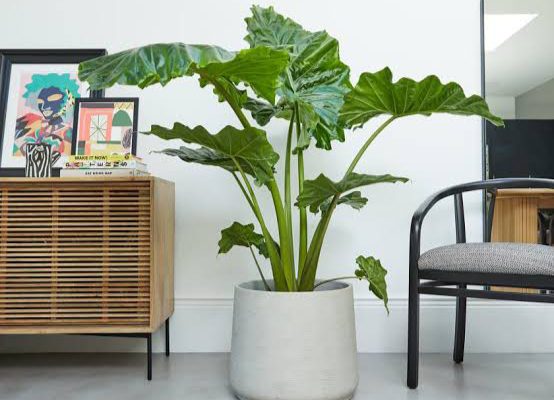
Alocasia portodora is all about glossy green, lush tropical foliage. The plant has huge emerald green leaves with wonderfully scalloped edges, sprouting from thick stalks – almost like a gigantic rhubarb plant. The upward pointing scalloped leaves on thick green stems give it the alternative name of upright elephant ear plant. Overall, these features add to the bevy attributes that’ll ensure your home space gets that exotic appeal.
Alocasia Sanderiana

Sanderiana, commonly known as the kris plant or Sander’s alocasia typically grows to over a metre in height, producing a thickened lower stem, termed a corm. Leaves are produced alternately, they are large, up to 40cm long by 20cm wide at their biggest. Leaves are arrow-shaped and deeply lobed, coloured dark green on the upper surface, with attractive, white veins and green-red on the underside. Leaves are produced on individual stems, which are brown in colour, approximately 60cm tall and often mottled in appearance.
Alocasia Rubra

Alocasia rubra has distinctive large arrow-shaped leaves that are dark green on the top and dark red or burgundy underneath. It adds a lot of focal impact in the tropical garden and patio containers.This plant will also make the ultimate statement plant if placed on its own or will add texture, tone and variation to a perfectly curated plant corner.
Alocasia Lauterbachiana
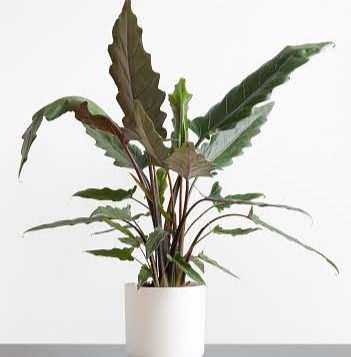
The Alocasia Lauterbachiana is impressive because of the shape of its leaves on top of the other elements that make Alocasias a perfect houseplant.The glossy green leaves are long and narrow with wavy leaf edges. They feature purple-colored undersides, creating an interesting combination of color, shape, and leaf texture that make this Alocasia variety really stand out. Indoors, the plant usually caps its height at around 3 feet, with a width of 3 to 5 feet. Outdoors, in ideal conditions, it can grow even taller.
Alocasia Dragon Scale
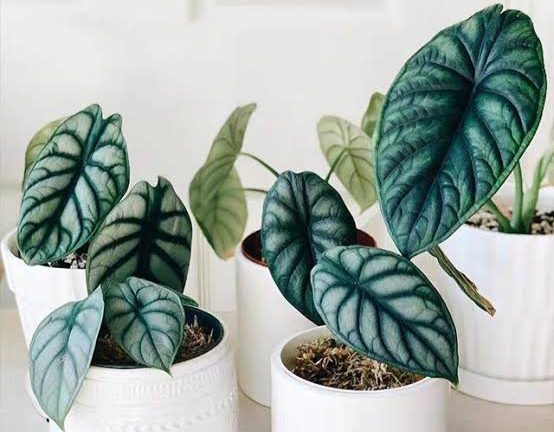
Alocasia Dragon Scale is a cultivated variety of Alocasia baginda, which is native to the tropical forests of Borneo. Alocasia Dragon Scale’s silvery-green leaves are darker towards the center, giving the lighter shade a luminous tone. The undersides are pale cream, with vibrant maroon veins. The coloration on young leaves deepens with maturity. The plant is striking at any size and stands alone or contrasts nicely with other plants. It likes tight quarters and is an excellent candidate for a terrarium.
Also Read: Different Types of Black-eyed Susan
Alocasia Odora

The Alocasia Odora is a rhizomatic plant that is known for beautiful, large green arrow shaped leaves and strong stem. Like most Alocasia plants, its size varies depending on the conditions it is provided. Outdoors, the plant can grow to anywhere from 8 to 15 feet tall and 8 to 15 feet wide. Indoors, its size will be more manageable at about 4 feet high and 4 feet wide. The plant is also known by a few common names including nigh scented lily, giant upright elephant ears and Asian taro.
Alocasia Nebula
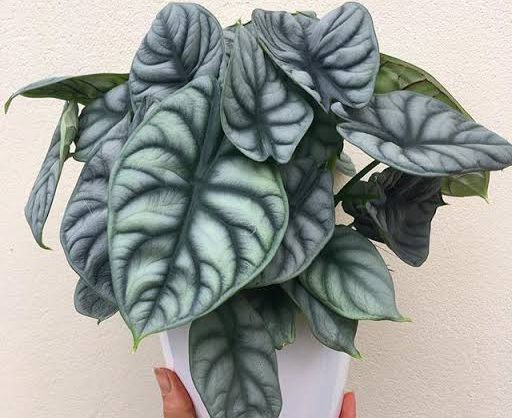
Alocasia nebula is among the rare variety of Alocasia and one of the world’s most sought-after jewel Alocasia. Its mature coloration is otherworldly. The leaves are a deep blue/silvery grey with 2 sets of radiating patterning, one thick and the other fine and elegant. The undersides of the leaves are a vivid purple and the plants can get over 2 feet across. During their juvenile stages, most plants have a green/gray coloration.
Alocasia Reversa

The Alocasia reversa is a beautiful and very rare exotic plant. It is characterized by thick smooth leaves that are different tints of green. What makes this Alocasia variety so unusual is the color patterns on the leaves of the plant that is quite different from most Alocasia. Most Alocasia have light-colored veins on their leaves. However, the Alocasia reversa has dark-colored veins, which makes its pattern reverse. That is also why this plant is called “reversa”. The leaves of this plant grow to become 8 inches long, while the plant itself grows to about 16 inches tall.
Alocasia Scalprum

Alocasia Scalprum has thick and rubbery leaves with intricate venation, which are of a narrower, much more arrowhead-like shape than other Alocasia. New foliage emerges in a lighter green, but fades down into a beautiful, dark green with a slight tinge of blue.The plant is striking at any size and stands alone or contrasts nicely with other plants. It likes tight quarters and is an excellent candidate for a terrarium.
Alocasia infernalis

Alocasia infernalis is relatively new on the ornamental plant scene.This beautiful Alocasia plant produces Oval-shaped leaves. These round leaves have a deep, dark green colour. It’s often referred to as “Black Magic” due to the beautiful black sheen that comes from the leaves, giving the impression that the leaves are black. This plant adds a lot of focal impact in the tropical garden and patio containers.
Also Read: Different Types of African Lily (Lily of the Nile)
Alocasia brancifolia
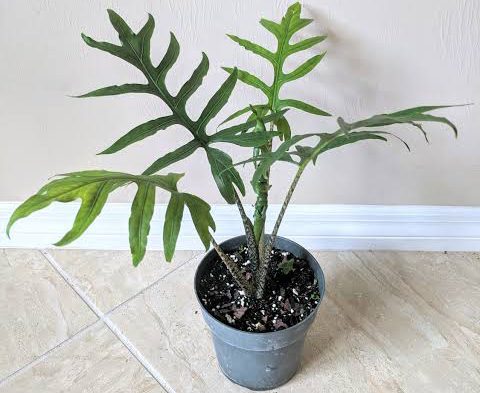
Alocasia brancifolia is a rare green houseplant from the aroid family. Leaves grow to 60 centimeters and arise from a rosette. The arrow shaped leaves are highly dissected which gives them a fern shaped look. This plant grows most optimal in warm areas or indoors.
Difference Between Alocasia And Colocasia
- Alocasia and Colocasia are both plants of the Araceae family. Both species have very large leaves, and both are called elephant’s ears.
- The stiff leaf stems, or petioles, of Alocasia extend into the leaves. This causes the leaves to follow the line of the petioles. As a result, most Alocasia leaves tend to point upwards. The petioles of Colocasia connect down from the notches in the leaves. This enables the leaves to droop or hang at a downward angle.
- Alocasia plants need soil that drains well and doesn’t stay soggy. Colocasia thrives in wet soil; unlike Alocasia, it can be grown in standing water.
- Alocasia plants grow best in shade or partial sun. Colocasia grows best with full sun exposure.
- Alocasia develops both tubers and rhizomes. Colocasia produces only tubers.
- To propagate Alocasia, a tuber is separated from the main growth and replanted. Propagation of Colocasia is by separating and planting the tubers.
- Many Colocasia varieties are grown for their edible tubers, called taro. However, most varieties of Alocasia are not edible. Some are highly poisonous and eating them could be fatal. A few Alocasia varieties have edible stems, as opposed to the edible tubers of Colocasia.
Propagation of Alocasia
The best method to propagate the alocasia plant is through rhizome division. Division should be done in the spring or early summer after the plant comes out of winter dormancy. Use a shovel to dig the parent plant out of the soil. Digging should be done in a circular shape 12 inches from the plant to preserve the root system. Gently remove the dirt and pull apart the bulbs into multiple sections. Ensure care to avoid damaging or removing the root system.
Growing Alocasia In Containers
You can propagate elephant ears by seed, runner or by transplanting. Elephant ears like to grow in soil that is consistently moist. Use a rich soil between 5.5 and 7.0 pH.
Plant bulbs about 2 to 4 inches under the soil. Darker varieties can be grown in partial shade, but the lighter cultivars grow best in full light. They need warm temperatures and prefer high humidity. Remember, when growing elephant ears in pots, the bigger bulbs result in larger plants. Fertilize the plants generously when they are first growing. During the spring and summer, they should be fertilized once every month with a liquid fertilizer, or use slow-releasing capsules at the start of the season.
Elephant ears can reach heights of up to 9 feet with a spread of up to 10 feet. In the wild, leaves grow up to 3 feet wide. Because of their size, growing elephant ears in pots should be done in 3-gallon containers or larger. When you are growing elephant ears indoors, they thrive in a greenhouse or hothouse because of the high levels of humidity needed. The plant rarely flowers indoors.